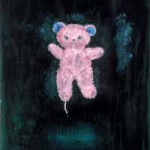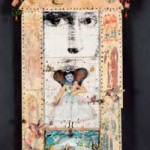Pretty Sweet: The Sentimental Image in Contemporary Art
DeCordova Museum and Sculpture Park
Including: Leika Akiyama, Ilona Anderson, Robert Arnold, Doug Bell, Kathleen Bitetti, Dana C. Chandler, Jr. (Akin Duro), Cynthia Constentino, Christine Couture, Maryjean Viano Crowe, Katherine Desjardins, Ben Freeman, Amy Goodwin, Michela Griffo, Judy Haberl, Lorie Hamermesh, Coleen Kiely, Catherine McCarthy, Blake Ogden, Roberta Paul, Amy Podmore, David Prifiti, Claudia Ravaschiere, Kay Ruane, Neil Salley, Gail Spaien, Anne Spileos Scott and David C. Scott, Edith Vonnegut, Candace Walters and Brenda Atwood Pinardi, Ann Wessman, Lucy White, and Maxine Yalovitz-Blankenship
Through April 17
In the arts is it more meaningful to laugh or cry? This subject was first explored and defined by the Greek philosopher, Aristotle, in his “Poetics and Theory of the Fine Arts.” While he acknowledged the importance and impact of the comedies of Aristophanes his paradigm for drama was “The Oedipus Cycle” of Sophocles.
If, as Forrest Gump would say “Life is a box of chocolates” then sentiment or sentimentality, as brilliantly and hilariously explored in the DeCordova exhibition “Pretty Sweet: The Sentimental Image in Contemporary Art” is devouring it whole in a single sitting. You make require a shot of insulin to break down and absorb all the treacle spooned out and slopped up in this timely, provocative, amusing and insightful group show of some 35 New England based artists. As the curators, Nick Capasso and Alexandra Novina, aptly put forth in a scholarly and well crafted catalogue, they well may be onto something big as this survey gleans from a plethora of recent exhibitions in area commercial and academic galleries. You might even call it a trend. Or fad.
In the matter of tears vs. laughter why is it that the solemn and tragic lingers and inhabits us while humor proves to be light and ephemeral. Tragedy strikes us deeply and profoundly while comedy is viewed as light hearted and of the moment.
During two back to back seasons of London Theater, for example, when for ten days stretches we saw a rich and diverse menu of shows just what lingered? Never to be forgotten experiences of theater? Most singularly and profoundly there was “Medea” a stunning and harrowing version of Euripides by Fiona Shaw. Planted forever in the psyche. But, arguably, no less so “Gerry Springer: The Opera.” Positively brilliant. Epic theater on every level. Astrid was skeptical when I announced an intention to see that (sold out) show. We were incredibly lucky to score tickets to a Saturday matinee on our last day in London when she preferred to stroll in Hyde Park. There is never much time for such leisure on our dense and intense trips abroad. We both loved “Springer.” What guilty pleasure. But equally and no less so than the grim experience of “Medea.” Or an existential treatment of “Caligula” by Camus in a small theatre. But, dare I admit it, the season before we adored “Mama Mia.” Yes folks, ABBA. They wrote exquisite rock songs. Is liking ABBA a sign of senility or terminal sentiment?
I came of age in the arts during a very serious era. Our thinking was dominated by Clement Greenberg. All that serious abstraction. Clem wasn’t very funny. Capasso quotes him in a famous essay “Avant-Garde and Kitsch.” Greenberg was all about defending the purity and sanctity of high art against the common and vulgar attractions of popular culture. Needless to say formalism got washed out to sea by the tsunami of Pop art. Johns, Rauschenberg and Warhol among others allowed for the serious and highbrow deconstruction and irony of consumerism and mass culture. As Capasso points out it is ok today to admire and be influenced by Disney and Normal Rockwell.
The notion of Camp, as rooted in queer culture, allows us to laugh with and not just at Liberace, Siegfried and Roy, Gilbert and George, Koons, Dolly Parton, the Dixie Chicks, Jennifer Lopez, Brittney Spears, Michael Jackson, Travis Twit, Tom Hankie Pankie, Sizzilie Stix, Susy Slut, Annie Sprinkle, Chris Kringle, Chris Rock, Brian Wilson, Hank Williams Jr. (“Are Your Ready for Some Football”) Bud Light, and last but not least, George W. Bush League.
In other words, if you think it is all pretty funny, and laugh all the way to the bank, you are a Republican. If you’re not laughing as we go to hell in a handbasket, then you are a Democrat. Silly people, the sentimentalists, live in the Red States and serious ones in the Blue States. Like Dr. Strangelove, learn to laugh and like the bomb.
But this is an old aesthetic argument. Nothing new here. Capasso recounts the debates of modernism when sentiment ruled the French salon with the kitsch of Bouguereau, Cabanal and Couture. Modernism assigned these popular artists to the dust bin of history. But Post Modernism, for example, Robert Rosenblum’s “19th Century Art” dragged them back into the light. He is the most prominent high brow defender of kitsch from Koons to Rockwell. All those “bad” artists are now back on display in the Musee d’Orsay where once again, devoid of irony, they are immensely popular with the general public.
Or, during the Renaissance, why did the Medici pay good money for bad art? Today the decorative sentimentality of Benozzo Gozzoli’s “Medici Family as the Magi” is painfully obvious. What crap. He was an assistant of Fra Angelico whom some regard as sublime. Not me. Too sweet (the word of the moment). Just how can you trust an artist who is frocked? Just how frocked up is that? Or Luca della Robbia? Do we really take all that glazed fruit and Madonnas seriously? Compare, for instance, “Cantoria” in the Cathedral of Florence (his most important work), to the more profound companion work by Donatello.
But Post Modernism levels those older notions of connoisseurship, Panofsky’s studies of iconography, and the formalism of Greenberg, to the lowering of standards and taste. We are in the affirmative action phase of art where anything and everything is handicap accessible. No artist left behind. It is like Garrison Kellior’s tongue in chic opening to “Prairie Home Compaion” where “every woman is beautiful and all the children are well above average.”
Is it specious then, a matter of de gustibus, to argue the merits of good and bad, right and wrong, in a cultural milieu of Post Modern permissiveness? If anything goes than what is the role of the critic? Does that reduce the committed cultural commentator to the position of nay sayer, curmudgeon, and party pooper? Should we just drop some ecstacy (never tried that) dance all night, suck on a pacifier, blow whistles, hug trees and love the universe? Too scary.
So where does that leave us in a show like this? Such alien territory.
Well, actually, liking, respecting and admiring a lot of the work. Guilty pleasure. Based on numerous shows I have seen and covered in the past few years, Capasso and Novina are timely and accurate in having their finger on the pulse of what is happening right now.
Let’s start with a terrific piece, the colorfully decorated, lovingly restored, VW Bug by Annee Spileos Scott and David C. Scott. What a hoot. To drive your car right into the main gallery of the deCordova. This vividly recalled a show last year at the Rotenberg Gallery Annex in which Annne had a dense installation of her 60s memorabilia and this car parked outside. It was trippy man. Or, as her sign states, “If you remember the 60s you weren’t there.” Like wow man. Heavy.
The performance, conceptual artist, Kathleen Bitetti, is everywhere in this show. Lots of little plaster birds along the steep stairs leading to the galleries, books specially marked in the library, and even posters fixed to the walls of the stalls in the rest rooms. Her works, which involve community and student outreach, deal with issues of abuse. Like the text that grimly informs us that, “At first he was Prince Charming.”
As in a Grimm fairy tale, recent e mails from my colleague, Ilona Anderson, informed me that she has been pulling all nighters stitching madly to finish her piece for this exhibition. The artist has just returned from two very difficult years in South Africa. There she was confronted with arrays of colorful materials but was surprised to find feminine, “sentimental,” embroidered, white, cloth covers designed to camouflage tissue boxes. She has transformed these feminine objects into feminist tropes. The slits of the pieces, from which poke out bits of tissue, have been stitched with pink edges to transform them into the labia of vaginas. There is an arrangement of these disarmingly pretty, crafted pieces to form a Valentine’s heart. They comprise a vagina monologue.
The use of hair in the woven and crafted works by Ann Wessmann are far more profound and poignant than the generally light hearted theme of this exhibition. They combine samples of hair collected over many years from her grandmother, mother, brother, husband and daughter as well as her own. She has taken much further the notion of saving locks of hair as signifiers of love and affection. In some pieces, in ever more inventive and varied ways, she literally weaves together generations of her family, living and deceased. Her work makes me sob and choke more than smile.
For quite some time I have admired the work of Lorie Hamermesh in a series of solo shows at Gallery Naga. It has really grown and evolved. Right now it involves images of women in which there is a layering of elements suspended over background images, usually a nude. The figure is “dressed” as we look through progressive layers. There is a subtle eroticism as the accessorized female is more enticing than the naked one. Consider, for example, that Manet’s “Olympia” is propped up nude but wearing pumps and with a choker tied around her neck. Only bad girls wear their shoes to bed as a fetish item. Hamermesh is a very refined and tasteful artist but the work turns me on.
I hope the lawyers at Disney don’t soon discover the delightful and playfully provocative works of Michela Griffo. She combines a narrative in several parts. In one, on the left we see the spinning figure of skater Nancy Kerrigan, and Disney characters on the right. A noir cartoon strip amusingly recalls her tragic run in with that trailer trash athlete, Tonya Harding. “Why me, why me,” Nancy screamed in pain after getting bonked on the knee, just before competition, by an alleged associate of Harding. After a heroic comeback Nancy was edged out of the gold by a Russian ice princess, Oxana Bayul (who later was DUI when she slammed the Porsche into a tree in Connecticut). Kerrigan sulked with the silver during a tense awards ceremony. Nancy was similarly less than gracious when she passed up the closing ceremony of the Olympics to pick up some gold by participating in a parade at Disneyland. Trouble was that the mike saw on when she dissed the event to her Mom seated beside her. Fortunately, we haven’t heard much of Nancy (local talent) since then. She went on to marry her manager who divorced to do so. Griffo relates all this with ironic insight and she is a wonderfully crisp and skilled painter.
Ever clever sculptor Judy Haberl here wires a wall of bronzed baby shoes (do they still do that?) into a broad arch that emits a chorus of music. It is a comment on parenting.
The single video in this show, what a relief, is absolutely fabulous. Robert Arnold has created a short loop that takes several minutes to run through. We view endlessly morphing couples as depicted in a variety of settings taken from the covers of paperback romance novels. The kind you see ladies reading on the subway commuting to work. Ah romance. It is a stunning experience to absorb the popular culture notion of love and romance. They recall the Richard Prince series of paintings based on blown up covers of cheap novels involving nurses. Prince is an artist who has deeply explored the theme of humor in high art.
There is a huge installation of neatly arranged stuff, the content of the studio, by the eclectic collector of material, Doug Bell. Last fall, I spent an afternoon with the artist viewing an installation and many small, assisted readymade pieces at the edgy alternative gallery, Hall Space. It was good to see the work again in this context. At the time I asked the artist if he knew of the work of Dieter Roth the subject of sprawling installations simultaneously at MoMA and PS 1. I see a real relationship in their work. The primary difference is that Bell is neat and organized while Roth was not. The notion here is stuff as art. The more the better.
The installation by Dana C. Chandler, Jr. (Akin Duro) was less successful. Just how did this black artist, known for strident protest work in the 1960s, evolve into an “installation artist?” The elements just don’t congeal. He was always known for having a huge cluttered studio, overgrown with tropical plants, but when did that environment evolve into his current art? Something here got lost in transit.
One of the pleasures of this exhibition is that visitors will debate what they like. I have highlighted works that I found compelling but could just as easily have focused on the found photo collages of Ben Freeman, the assemblages of the ever fascinating, MJ Viano Crowe, the wall drawings of Katherine Desjardins, the large paintings of stuffed toy animals by Maxine Yalovitz-Blankenship (a departure in her work for me), the hovering angels in bottles of Neil Salley, or the family based nostalgia Roberta Paul. With more time, space, and your patience, I might have covered what didn’t work.
But why break up a good party? Indeed, on a very bitter cold night, the DeCordova hosted the best attended and most festive party of the season. There was lots of good food and an open bar. As Meg of Gallery Naga quipped comparing the evening to an opening this past week, “The ICA didn’t serve cup cakes.” The DeCordova parking lots were jammed. All signs of a great event. That was last night. Tonight there is a blizzard coming. What great luck. Hey, timing is everything. So if you are feeling a bit down in the dumps, take a drive along upscale Trapelo Road to Posh Lincoln. But then, I wax sentimental.
- Maxine Yalovitz-Blankenship, Wind-up, from the series A One Act Play in Pantomime, acrylic, sand, embroidery thread on paper, 2003.
- Maryjean Viano Crowe, (Welcome to) Girl World, mixed media, 2004.
Links:
DeCordova Museum and Sculpture Park
All images are courtesy of the the artist and the DeCordova Museum.






